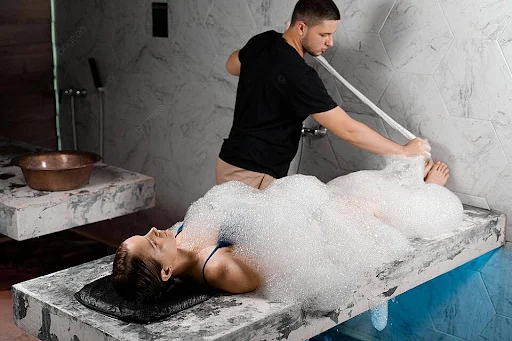Foam massage has become one of the most relaxing spa rituals, combining cleansing and therapeutic touch. Inspired by the traditions of the Morocco bath, it offers a unique blend of warmth, silky foam, and gentle massage techniques that restore both body and mind.
Foam massage is not simply about cleansing the skin. It is a ritual that blends the soothing touch of classical massage with the gentle embrace of silky, aromatic foam. The warm, airy texture spreads evenly across the body, reducing friction and creating a unique balance of relaxation and care. Unlike traditional deep‑tissue techniques, this method focuses on comfort, sensory pleasure, and holistic renewal.
The ritual has its roots in the hammam, the traditional Eastern steam bath, where heat, steam, and foam come together to create a deeply restorative experience. Today, it is offered in spas around the world as a way to combine skin care, relaxation, and emotional reset in a single session.
What makes it special
The foam is prepared fresh for every guest. Natural olive soap is whipped into a soft, cloud‑like texture that glides across the skin. This soap is rich in vitamins A and E, which nourish and protect, as well as omega fatty acids that strengthen the skin’s barrier and lock in moisture. Polyphenols add antioxidant power, helping the skin stay youthful and radiant.
The session usually takes place on a heated marble surface, where warmth relaxes the muscles and opens the pores. The therapist may use a kessa glove for gentle exfoliation, but the main focus is on smooth, rhythmic massage movements. Because the foam stays on the skin throughout the session, it enhances the therapeutic effect while surrounding the body in a cocoon of softness.
Unlock more context — this related post deepens understanding with key takeaways.
Benefits you can feel
Foam massage works on several levels at once. Physically, it deeply cleanses the skin, removing impurities and dead cells without harsh scrubbing. It stimulates circulation, bringing oxygen and nutrients to the tissues, and supports lymphatic flow, which helps reduce swelling and puffiness.
On a muscular level, the gentle warmth and flowing movements relieve tension in muscles, joints, and ligaments. This makes it especially helpful after exercise or long hours of sitting. Emotionally, the combination of heat, aroma, and touch creates a sense of calm that can ease stress, improve sleep, and restore inner balance.
Regular sessions may also support immunity, as steam and massage together strengthen the body’s natural defenses. For those concerned about appearance, foam massage can smooth the look of cellulite, improve skin tone, and leave the body feeling lighter and more energized.
When it is recommended
Foam massage is suitable for a wide range of people. It is often chosen by those with:
- chronic muscle tension or fatigue
- poor circulation or swelling in the legs
- early signs of cellulite or reduced skin tone
- a need for detox and metabolic support
- stress, burnout, or sleep problems
It can also be part of recovery after minor injuries, provided a doctor approves. Many spa programs combine foam massage with wraps, masks, or oil treatments for a complete wellness experience.
When to avoid it
Because the ritual takes place in a hammam, with heat and humidity, there are some important restrictions. Foam massage is not recommended for people with acute infections, uncontrolled heart conditions, cancer, thrombosis, advanced varicose veins, or active skin diseases. It is also not advised during pregnancy, especially in the first and third trimesters. As with any thermal or massage treatment, consulting a doctor is the safest choice if you have chronic conditions.
How the ritual unfolds
A session follows several stages:
- Warming up in the steam room. The guest spends time in the hammam, where warmth and humidity relax the body, open pores, and prepare the skin.
- Application of foam. Freshly whipped soap foam is spread across the body with a kessa glove, gently cleansing and softening the skin.
- Massage in foam. The therapist uses smooth strokes, light kneading, and gentle tapping, focusing on relaxation, circulation, and lymphatic flow. The foam’s silky texture distributes pressure evenly, making the experience especially comfortable.
- Completion. The foam is rinsed away with warm water, and the guest may continue with scrubs, wraps, or oil massage for deeper nourishment.
A standard session lasts about 45 minutes. Specialists recommend no more than two or three times per week to avoid overloading the skin barrier.
A ritual of balance
Foam massage is more than a way to relax. It is a sensory journey that cleanses, restores, and helps you reconnect with yourself. For anyone looking to ease stress, improve circulation, and bring back natural energy, this ritual offers a gentle yet powerful path to renewal.
Adventure awaits — explore more content that challenges and informs alike.






